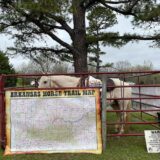National Trail Maintenance Backlog and BCHA
If you ever wonder why our trail work is so important, read on. As you can see from the following National Park Service release, our national parks have quite a maintenance backlog, and they are not alone. The National Forest Service has reported that fewer than 25% of our national trails are maintained to standard, mainly due to budget constraints.
The concern is that this large backlog will eventually lead to trail closings and damage to natural resources. Both agencies agree they cannot solve this problem alone and have recognized the importance of greater collaboration with their volunteer partners, including Back Country Horsemen of America. Of course,volunteers like us are just one piece of this puzzle, but isn’t it good to be part of the solution? Annually BCHA, which includes our local Buffalo River Chapter, contributes more than $10 million dollars worth in volunteer labor to ensure our public trails will remain open to everyone…work that is more important than ever.
National Park Service Press Release
For Immediate Release: February 05, 2016
Contact(s): Jeffrey Olson, Jeffrey_olson@nps.gov 202-208-6843
National Parks maintenance backlog reaches $11.9 billion
WASHINGTON – The National Park Service (NPS) this week released its Fiscal Year 2015 deferred maintenance statistics for national parks. The $11.93 billion nationwide total is a $440 million increase from the previous year.
Deferred maintenance is necessary work – performed on infrastructure, such as roads and bridges, visitor centers, trails and campgrounds – that has been delayed for more than one year. Aging facilities, increasing use of park facilities and scarce resources contribute to the growing backlog.
“While Congress provided increases this year, the annual bill for maintenance in America’s national parks is still almost twice as much as is appropriated,” said National Park Service Director Jonathan B. Jarvis.
Congressional funding for the National Park Service in 2016 includes an additional $90 million for non-transportation maintenance. Congress also passed a new highway bill which will provide a $28 million increase for transportation projects in parks this year. Funding for transportation-related maintenance and construction will continue to rise, by $8 million per year for five years, until it reaches $300 million per year in 2020.
Nearly every unit in the National Park System has maintenance items that have been deferred. Regions regularly evaluate and prioritize project submissions to ensure available dollars make a difference, and will be using the new funds to address the highest priorities. For details about deferred maintenance at a particular national park, visit go.nps.gov/deferredmaint and click on the “NPS Asset Inventory Summary by Park” report.
Even though more maintenance items had to be deferred in 2015, these increases from Congress are welcome. Jarvis said they are part of a multifaceted approach to end the growth of deferred maintenance and eventually have enough resources to keep pace with annual maintenance responsibilities.
“We have a lot yet to do but I think everything is moving in the right direction,” Jarvis said of the deferred maintenance issue. “Congress has pitched in with base funding and with additional funds for the Centennial Challenge – a program that enables us to leverage private and non-profit partner contributions to complete important projects that improve visitor services in parks. There is more Congress can do through the Centennial Act now under consideration including short-term mandatory appropriations.”
About the National Park Service. More than 20,000 National Park Service employees care for America’s 409 national parks and work with communities across the nation to help preserve local history and create close-to-home recreational opportunities. Visit us at www.nps.gov, on Facebook www.facebook.com/nationalparkservice, Twitter www.twitter.com/natlparkservice, and YouTube www.youtube.com/nationalparkservice.




